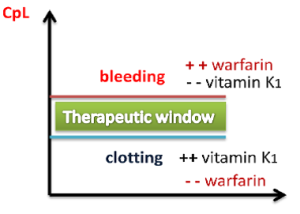Now that the basic concepts of medication onset, peak, and duration have been discussed, it is important to understand the value of the therapeutic window and therapeutic index in medication administration.
Therapeutic Window
For every drug, there exists a dose that is minimally effective (the Effective Concentration) and another dose that is toxic (the Toxic Concentration). Between these doses is the therapeutic window, where the safest and most effective treatment will occur (see Figure 1.7).[1] Think of this area as the dosing “sweet spot.”

For example, warfarin (Coumadin) is a medication used to prevent blood clotting and is monitored using a blood test called INR. Too high of a dose of warfarin would cause the INR to increase above the therapeutic window and put the patient at risk of bleeding. Conversely, too low of a dose of warfarin would cause the INR to be below the therapeutic window and put the patient at risk of clotting. It is vital that the nurse frequently monitors INR levels for a patient receiving warfarin to ensure the dosage appropriately reaches the therapeutic window and does not place the patient at risk for bleeding or clotting.
Peak and Trough Levels
Now let’s apply the idea of therapeutic window to the administration of medications requiring the monitoring of peak and trough levels, which is required in the administration of some IV antibiotics. It is important for the dosage of these medications to be titrated to achieve a desired therapeutic effect for the patient. Titration is often accomplished by closely monitoring the blood levels of the medication. A drug is said to be within the “therapeutic window” when the serum blood levels of an active drug remain consistently above the level of effective concentration (so that the medication is achieving its desired therapeutic effect) and consistently below the toxic level (so that no toxic effects are occurring). A peak drug level is drawn at the time when the medication is being administered and is known to be at the highest level in the bloodstream. A trough level is drawn when the drug is at its lowest in the bloodstream right before the next dose is given. Medications have a predicted reference range of normal values for peak and trough levels. These numbers assist the pharmacist and provider in gauging how the body is metabolizing, protein-binding, and excreting the drug, and assist in the adjustment of the prescribed drug doses to keep the medication within the therapeutic window. When administering IV medications that require peak or trough levels, it is vital for the nurse to time the administration of the medication according to the timing of these blood draws.[2]
Therapeutic Index
The therapeutic index is a quantitative measurement of the relative safety of a drug. It is a comparison of the amount of drug that produces a therapeutic effect versus the amount of drug that produces a toxic effect.
- A large (or high) therapeutic index number means there is a large therapeutic window between the effective concentration and the toxic concentration of a medication, so the drug is relatively safe.
- A small (or low) therapeutic index number means there is a small therapeutic window between the effective concentration and the toxic concentration. A drug with a narrow therapeutic range (i.e., having little difference between toxic and therapeutic doses) often has the dosage titrated according to measurements of the actual blood levels achieved in the person taking it. For example, patients who start taking phenytoin to control seizures have the drug levels in their bloodstream measured frequently.
Critical Thinking Activity 1.10
Mr. Parker has been receiving gentamicin 80 mg IV three times daily to treat his infective endocarditis. He has his gentamicin level checked one hour after the end of his previous gentamicin infusion was completed. The result is 30 mcg/mL. Access the information below to determine the nurse’s course of action.
View information on therapeutic drug levels.
(After accessing the information, be sure to select “click to keep reading” in order to view drugs that are commonly checked, their target levels, and what abnormal results mean.)
Based on the results in the above patient scenario, what action will the nurse take based on the result of the gentamicin level of 30 mcg/mL?
Note: Answers to the Critical Thinking activities can be found in the “Answer Key” sections at the end of the book.
- “Therapeutic Window” by Shefaa Alasfoor is licensed under CC BY-SA 3.0 ↵
- This work is a derivative of Principles of Pharmacology by LibreTexts and is licensed under CC BY-NC-SA 4.0 ↵
The dosing window in which the safest and most effective treatment will occur.
The process of adjusting the dose of a of medication for maximum benefit and least risk of complication.
When the maximum concentration of drug is in the body.
A level of blood that is drawn when the medication is at the lowest level in the bloodstream.
A measurement of the amount of drug that produces a therapeutic effect compared to the amount of drug that produces a toxic effect.
